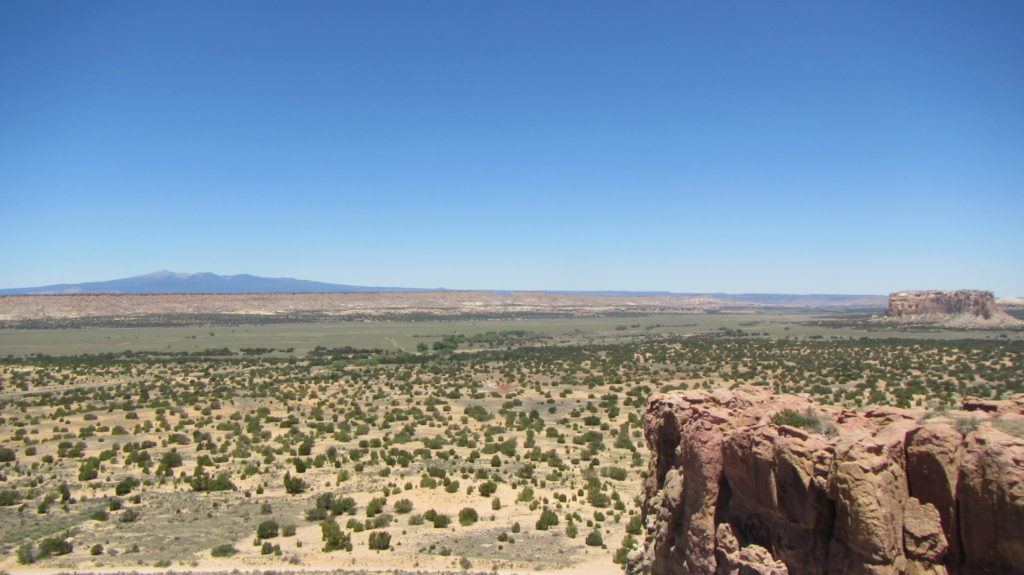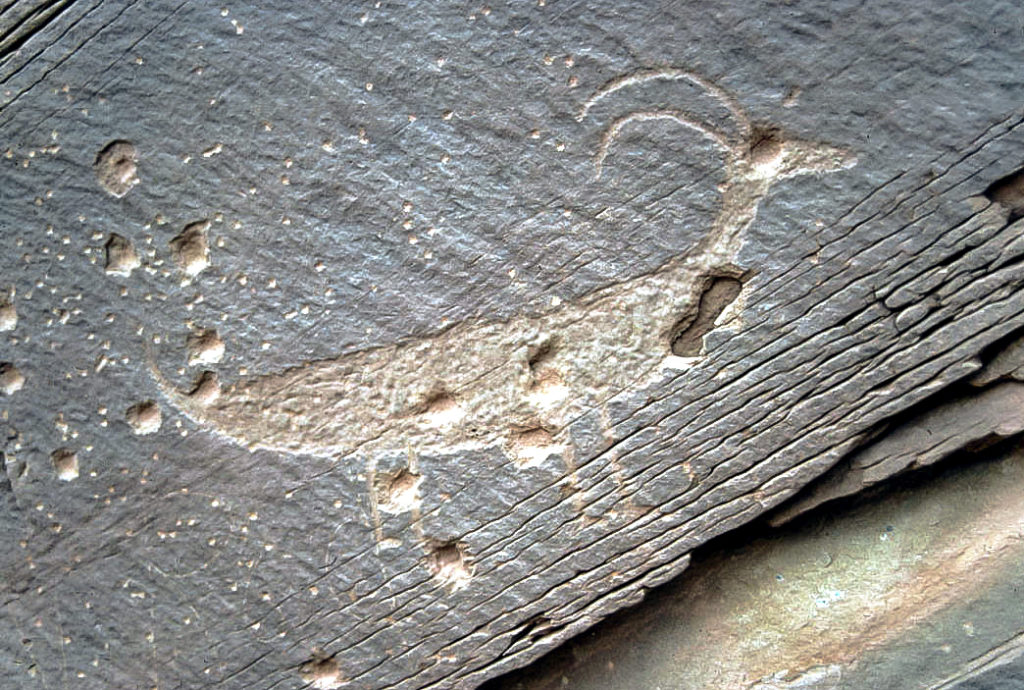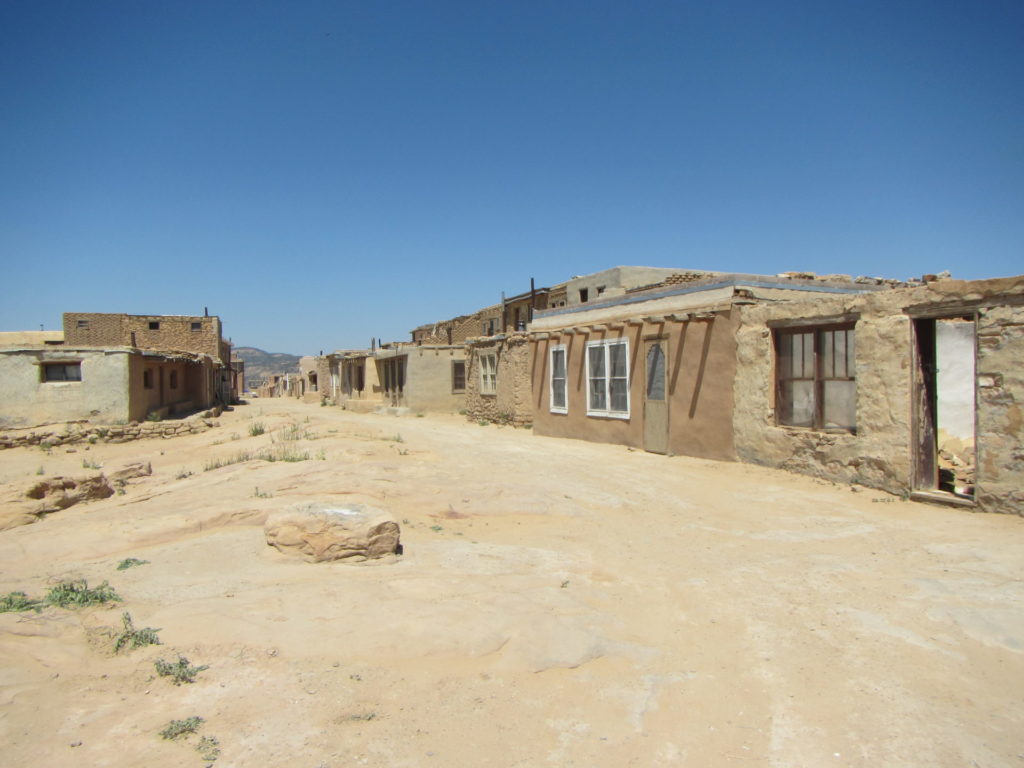- Home
- >
- Preservation Archaeology Blog
- >
- Connections to Place: An Interview with Todd Sciss...

(September 11, 2020)—Several months ago, I attended a webinar that focused on efforts to stop vandalism at archaeological sites and heard Todd Scissons, the Tribal Historic Preservation Officer for the Pueblo of Acoma, remark on the need to engage tribal communities in public education and site protection efforts. I did not know Todd at the time, but I wanted to hear more, and he graciously agreed to this interview. I think you’ll find Todd’s perspective on the significance of archaeological resources as meaningful as I do.
This interview has been edited for length and clarity.
Stacy: Can you tell me a little bit about your position and about what inspires you to do this work?
Todd: I’m the Tribal Historic Preservation Officer for the Pueblo of Acoma in New Mexico. My main job responsibilities are to protect, manage, and promote our culture and traditions. I was here back in 1996 when myself and two other individuals started the Historic Preservation Office. I left for other endeavors but found my way back.
My passion for this work comes from the fact that I am Native American, and learning and understanding this history has allowed me to focus on protecting cultural resources. I have a B.A. in anthropology with a minor in history. It’s been a passion of mine to be involved in archaeology, but over time this has evolved into protecting my cultural history. I have concerns, and almost all Pueblo Tribes have concerns, that this is not being done the right way.
Stacy: I’ve heard you comment on the importance of understanding the human connection to archaeological sites. Can you elaborate on what the archaeological sites and cultural landscapes in the Four Corners region and beyond represent to the Pueblo of Acoma community?
Todd: One of the things that I am outspoken about is the idea and use of the phrase “cultural landscape.” This only recently became part of reports, documents, and the overall understanding of various regions. We, as Native people, and I, from Acoma, believe that every part of this region where our ancestors lived and migrated through is all connected as one cultural landscape. This includes not only the archaeological resources but also the landscape itself: the rivers, valleys, mountaintops, deserts, and vegetation. To us, they’re all interrelated.

We are told stories of migrations that took place far to the north centuries ago, and their final stop was here at Acoma, the place already prepared, or Haak’u as we call it in our language. Other Pueblo tribes have similar stories. We know that our people migrated through the Bears Ears National Monument, south through Canyons of the Ancients, Mesa Verde, Chaco Canyon, and then of course to the modern-day pueblos. There are stories of some of our people continuing south as far as Mexico.
These stories, this history, we hold dear to our hearts, and it is why these areas and archaeological resources are important to us. I vocalize the importance of cultural landscapes at every meeting and consultation. Not just specific archaeological sites, but everything that you see, touch, and feel is all part of this cultural landscape and symbolizes something.
Stacy: Thank you for that explanation. I think it’s important to understand the significance of cultural landscapes because so many people go to these places for recreation. It is important for people to know what these places mean and to treat them with respect.
Todd: Correct. We push for bringing awareness to the public because they visit these places but do not understand what they represent to Native Tribes and the connections we have to these places.
Stacy: We know that vandalism, theft, and grave robbing are a persistent threat to cultural resources in the Southwest. What types of damage have you observed or have been reported to your office?
Todd: We see many types of damage, and one common type is damage to petroglyphs. People see petroglyphs as just drawings and don’t understand what they represent. Unfortunately, people will shoot them up, paint over them, or they will cut out petroglyphs with equipment because they want to take them home.

We also see archaeological sites that have been bulldozed or cut by a road because [cultural resource] surveys weren’t properly done. All of these sites are important. They each tell a certain story of our people and need to be protected.
Stacy: How do these destructive acts impact your community?
Todd: People may consider archaeological sites to be abandoned homes that no one lives in and cares about anymore. We, as Pueblo Tribes, consider these places not as abandoned structures but as villages, sacred places that our ancestors lived in long ago, and their spirits still live in these places. It impacts Native communities because when we do our traditional practices, we refer back to these places. We use their power, their energy. They keep our communities going and our traditions alive. When these places are destroyed, a little bit of that tradition is taken away from us. Our identity is taken away from us.
Another side to this is that environmental factors need to be taken into account when the land is being used. We see this in the Chaco region, where drilling and fracking is hurting the land. There are countless cultural resources and native plants we still use that no longer grow out there because of the drilling. If the landscape is damaged, if the groundwater is contaminated, native plants will not grow and animals cannot live there. This affects everyone, not just Tribes.
Stacy: Yes, absolutely. When you talk about the misconception that sites are abandoned, I realize it was not that long ago that I learned not to use the word “abandoned” because it sends an incorrect message.
Todd: Yes. The archaeological community has realized that the way they interpret these places needs to change and include Native input because we are the descendants of those people. And when they say that those people who lived in Chaco Canyon, Mesa Verde, and many other places disappeared, well that’s not true. No one disappeared. They just moved, and we’re their descendants. We’re still here. All you have to do is come visit the Pueblos, speak with them, ask questions. We are happy to share with you what we can so that people understand who we are and where we come from.
Stacy: How can collaborations with Tribes help archaeologists and land managers protect sites and increase awareness that vandalism and looting must stop?
Todd: Interviews, collaborations, asking questions, and learning from Tribes are ways to better understand the cultural landscape. There are things that are sacred to us that we won’t divulge, but there is information that we do want to share. If agencies and communities reach out to us and ask to visit our village or meet with us, then we are happy to sit down and talk. It starts with a willingness to make contacts, and don’t be afraid to ask questions.
And be open to what we have to say. It may not be the traditional way of thinking about things, the way that we were all taught in school, but we believe in our way and our traditions. Without our beliefs and traditions, we would not be here. What we see today with the racism, the discrimination, the hate that people are spreading comes from not truly understanding where the other person is coming from. But we are open to talking to anybody who wants to meet with us.
And we want that reciprocated. Allow us to sit down with you and talk about things. We want to work together to ensure that your projects are done properly and that our cultural resources are taken into consideration, managed, and protected.
Stacy: Thank you Todd, that’s a good message for everyone to hear, including me: Do not hold back on asking important questions.
We recently saw the good news that several sacred items were returned to the Pueblo of Acoma. Can you comment on the significance of this event?
Todd: Bringing these cultural items back home has been such an uplifting, spiritual, and positive experience for us. These are items of cultural patrimony that we use in our traditional practices. These aren’t just objects; they are living, breathing items that have a spirit, and it’s important that they come home. We had some really great help and support from various agencies along the way, including our congressional leadership, which allowed us to bring these sacred items back home. It was a huge victory for us, but even on a larger scale it is a big victory for Native Tribes, because now agencies are starting to realize how important these items are. They’re not just pieces of art or objects that can be sold.
We are certainly looking to the future, because we know there’s much more out there that needs to come back home. We’re working to identify what items are sacred and affiliated with a certain Tribe versus just regular pieces of art. These returns have opened the eyes of many museums, art galleries, and other institutions in the United States and throughout the world. It is important that they review their inventory of collections. If certain items are potentially affiliated with a Tribe and, more importantly, are an object of cultural patrimony, then they need to work with the Tribes to get these items back home.
Our hope is that more institutions and agencies work to return these items and start cracking down on illegal trafficking of sacred items. The ultimate goal is that there are tougher laws in place for people who want to take these items, whether they’re items of cultural patrimony or artifacts taken from places like Chaco Canyon and Mesa Verde. These items still mean something to the present-day Tribes and are considered sacred. There is a reason that these things were left behind. They should have stayed where they were instead of being looted.
This leads me to one of the more challenging issues: the amount of human remains that are out there. We continue to fight to get those repatriated and to be reburied in their ancestral homelands. We are fortunate to have been involved in thousands of repatriations of human remains, but there are probably still hundreds of thousands of sets of human remains out there that people have collected over time. This is one area where many institutions are willing to work with us, but we still see looting and human remains taken from various sites, and that needs to stop. These are our ancestors who were buried long ago to be sent back home. They could not complete that journey because they were taken from their homeland and place of rest. They need to be brought back home so they can finish that journey.
Stacy: I hope that this continues and the human remains return home where they are supposed to be. Is there anything else you would like to add, or a message you would like to convey to our readers?
Todd: First of all, I hope that people have a better understanding of the connection between Pueblo Tribes and these regions here in the Southwest, and that they understand the need to protect and properly manage cultural resources. And I hope that people understand the meaning of these places and are open to different interpretations. Because one way is not the only way; one idea is not the only idea.
Second, each Tribe has their own history, their own story that needs to be told, and their own traditions that they continue to practice because of their cultural resources that they still have. As we vocalize our concerns, my hope is that these messages get out there on a national level. All Tribes are dealing with the same problem of their cultural resources being damaged, destroyed, and stolen. That needs to stop.
And lastly, I want to leave you with something that my grandmother used to say. She passed away about 16 years ago. She always told us that no matter how different we may look and how different we do things, at one time we were all one people. We need to remember that and treat each other with respect and dignity, no matter where you come from. Mother Earth brought us here as one group, and she allowed us to be different, to do what was necessary for our own people. But in the end, we all come from one place. Let’s not forget that. In the end when we die and go back home, we all go back to the same place.
Stacy: Thank you, Todd, very much for taking the time to answer my questions. I’ve learned a lot, and I know that your words will have an impact on many people. Your grandmother sounds like a very wise woman.
Todd: She was. Thank you. I enjoyed sharing my thoughts and I’m happy to speak with anyone who has any questions or concerns. I am available, all you have to do is reach out.

To learn more about the events around a stolen ceremonial shield that was returned to Acoma after being put up for sale at a Paris auction house read this recent article in High Country News.
With the passage of the Native American Graves Protection and Repatriation Act in 1990, federally funded agencies and museums are required to work towards repatriation of human remains, funerary and sacred items, and items of cultural patrimony. Unfortunately, we know that sacred items and ancestral remains are still kept in private collections and that grave-robbing continues on Tribal and public lands in the Southwest.
If you encounter a recent act of vandalism or looting at an archaeological site on Tribal or public land, please call 1-800-637-9152 to report the incident.
4 thoughts on “Connections to Place: An Interview with Todd Scissons”
Comments are closed.
Very interesting and eye opening!
I agree! Thank you for reading and hearing Todd’s perspective!
Great to have Mr. Scissons’ views on these important matters. It occurs to me that Pueblo values, interests, and preferences should be primary drivers for the management of Pueblo cultural / heritage resources.
Thanks Stacy!
Yes, and it’s important to hear from Tribal members to understand how decisions and behaviors impact their communities. Thank you for reading!
-Stacy